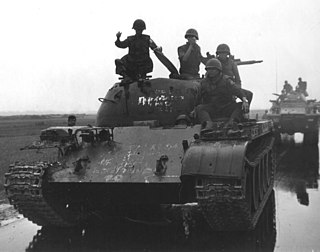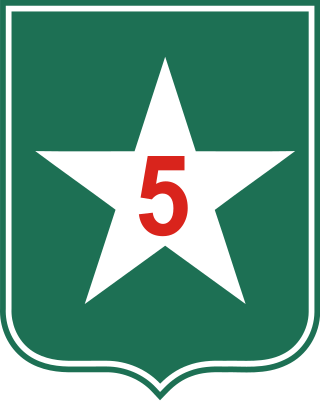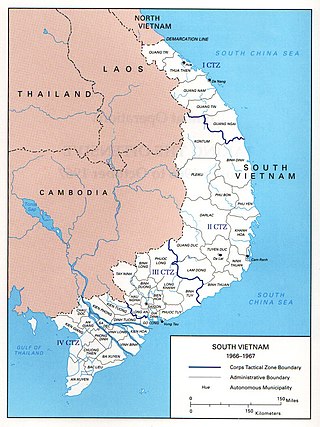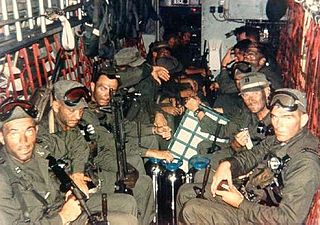
The Tet Offensive was a major escalation and one of the largest military campaigns of the Vietnam War. It was launched on January 30, 1968 by forces of the Viet Cong (VC) and North Vietnamese People's Army of Vietnam (PAVN) against the forces of the South Vietnamese Army of the Republic of Vietnam (ARVN), the United States Armed Forces and their allies. It was a campaign of surprise attacks against military and civilian command and control centers throughout South Vietnam. The name is the truncated version of the Lunar New Year festival name in Vietnamese, Tết Nguyên Đán, with the offense chosen during a holiday period as most ARVN personnel were on leave. The purpose of the wide-scale offensive by the Hanoi Politburo was to trigger political instability, in a belief that mass armed assault on urban centers would trigger defections and rebellions.

Vietnamization was a policy of the Richard Nixon administration to end U.S. involvement in the Vietnam War through a program to "expand, equip, and train South Vietnamese forces and assign to them an ever-increasing combat role, at the same time steadily reducing the number of U.S. combat troops". Brought on by the Viet Cong's Tet Offensive, the policy referred to U.S. combat troops specifically in the ground combat role, but did not reject combat by the U.S. Air Force, as well as the support to South Vietnam, consistent with the policies of U.S. foreign military assistance organizations. U.S. citizens' mistrust of their government that had begun after the offensive worsened with the release of news about U.S. soldiers massacring civilians at My Lai (1968), the invasion of Cambodia (1970), and the leaking of the Pentagon Papers (1971).

The Easter Offensive, also known as the 1972 spring–summer offensive by North Vietnam, or the Red Fiery Summer as romanticized in South Vietnamese literature, was a military campaign conducted by the People's Army of Vietnam against the Army of the Republic of Vietnam and the United States military between 30 March and 22 October 1972, during the Vietnam War.

Operation Union II was a search and destroy mission in the Quế Sơn Valley carried out by the 5th Marine Regiment. Launched on 26 May 1967 the operation ended on 5 June. U.S. reported the People's Army of Vietnam (PAVN) lost 701 killed and 23 captured, while U.S. casualties were 110 killed and 241 wounded.

The Cambodian campaign was a brief series of military operations conducted in eastern Cambodia in 1970 by South Vietnam and the United States as an extension of the Vietnam War and the Cambodian Civil War. Thirteen major operations were conducted by the Army of the Republic of Vietnam (ARVN) between 29 April and 22 July and by U.S. forces between 1 May and 30 June 1970.
The 1975 spring offensive, officially known as the general offensive and uprising of spring 1975 was the final North Vietnamese campaign in the Vietnam War that led to the capitulation of Republic of Vietnam. After the initial success capturing Phước Long Province, the North Vietnamese leadership increased the scope of the People's Army of Vietnam's (PAVN) offensive and captured and held the key Central Highlands city of Buôn Ma Thuột between 10 and 18 March. These operations were intended to be preparatory to launching a general offensive in 1976.

Operation Lam Son 719 or 9th Route – Southern Laos Campaign was a limited-objective offensive campaign conducted in the southeastern portion of the Kingdom of Laos. The campaign was carried out by the armed forces of South Vietnam between 8 February and 25 March 1971, during the Vietnam War. The United States provided logistical, aerial and artillery support for the operation, but its ground forces were prohibited by law from entering Laotian territory. The objective of the campaign was the disruption of a possible future offensive by the People's Army of Vietnam (PAVN), whose logistical system within Laos was known as the Ho Chi Minh Trail.
United States involvement in the Vietnam War began shortly after the end of World War II in Asia, first in an extremely limited capacity and escalating over a period of 20 years. The U.S. military presence peaked in April 1969, with 543,000 American combat troops stationed in Vietnam. By the conclusion of the United States's involvement in 1973, over 3.1 million Americans had been stationed in Vietnam.

Free World Military Assistance Forces was the group of five nations who sent troops to fight in the Vietnam War under the FWMF banner, assisting the United States and South Vietnam against the Viet Cong (VC) and People's Army of Vietnam (PAVN). Together with the U.S. and South Vietnamese, the FWMF were often referred to as the Allies.

I Corps was a corps of the Army of the Republic of Vietnam (ARVN), the army of the nation state of South Vietnam that existed from 1955 to 1975. It was one of four corps of the ARVN. This was the northernmost region of South Vietnam, bordering North Vietnam at the Vietnamese Demilitarized Zone (DMZ). These five provinces are Quảng Trị Province,, Thừa Thiên-Huế Province,, Quảng Nam Province,, Quảng Tín Province, and Quảng Ngãi Province,.

The Fifth Division of the Army of the Republic of Vietnam (ARVN)—the army of the nation state of South Vietnam that existed from 1955 to 1975—was part of the III Corps that oversaw the region of the country surrounding the capital, Saigon.

During the Cold War in the 1960s, the United States and South Vietnam began a period of gradual escalation and direct intervention referred to as the joint warfare in South Vietnam in the Vietnam War. At the start of the decade, United States aid to South Vietnam consisted largely of supplies with approximately 900 military observers and trainers. After the assassination of both Ngo Dinh Diem and John F. Kennedy close to the end of 1963 and Gulf of Tonkin incident in 1964 and amid continuing political instability in the South, the Lyndon Johnson Administration made a policy commitment to safeguard the South Vietnamese regime directly. The American military forces and other anti-communist SEATO countries increased their support, sending large scale combat forces into South Vietnam; at its height in 1969, slightly more than 400,000 American troops were deployed. The People's Army of Vietnam and the allied Viet Cong fought back, keeping to countryside strongholds while the anti-communist allied forces tended to control the cities. The most notable conflict of this era was the 1968 Tet Offensive, a widespread campaign by the communist forces to attack across all of South Vietnam; while the offensive was largely repelled, it was a strategic success in seeding doubt as to the long-term viability of the South Vietnamese state. This phase of the war lasted until the election of Richard Nixon and the change of U.S. policy to Vietnamization, or ending the direct involvement and phased withdrawal of U.S. combat troops and giving the main combat role back to the South Vietnamese military.

The year 1968 saw major developments in the Vietnam War. The military operations started with an attack on a US base by the North Vietnamese People's Army of Vietnam (PAVN) and the Viet Cong (VC) on January 1, ending a truce declared by the Pope and agreed upon by all sides. At the end of January, the PAVN and VC launched the Tet Offensive.

The inauguration of Richard Nixon in January led to a reevaluation of the U.S. role in the war. U.S. forces peaked at 543,000 in April. U.S. military strategy remained relatively unchanged from the offensive strategy of 1968 until the Battle of Hamburger Hill in May which led to a change a more reactive approach. The U.S. and South Vietnam agreed on a policy of Vietnamization with South Vietnamese forces being expanded and equipped to take over more of the ground combat from the departing Americans which began to withdraw in late June without any reciprocal commitment by the North Vietnamese. The morale of U.S. ground forces began to fray with increasing racial tensions and the first instances of fragging and combat refusal. The antiwar movement in the U.S. continued to grow and public opinion turned increasingly antiwar when the Mỹ Lai massacre was revealed in November.

The United States continued its unilateral withdrawal of forces from South Vietnam notwithstanding the lack of progress at the Paris Peace Talks. The removal of Prince Norodom Sihanouk from power in Cambodia in March and his replacement by General Lon Nol, began the Cambodian Civil War. South Vietnamese and U.S. forces entered Cambodia in late April to attack People's Army of Vietnam (PAVN) and Vietcong (VC) bases and supply lines there which had long been used to support the insurgency in South Vietnam. The expansion of the war revitalized the antiwar movement in the U.S. and led to the Kent State shootings and Jackson State killings in May. While U.S. ground forces withdrew from Cambodia at the end of June and legislation was passed to prevent their reintroduction, the South Vietnamese conducted operations in Cambodia for the rest of the year and the U.S. provided air support and military aid to the Cambodian government. Despite this support the Cambodians lost control of vast areas of the country to the PAVN. Within South Vietnam the second half of the year saw a reduction in large U.S. operations with the focus shifting to pacification and population security and supporting Vietnamization. The PAVN/VC generally reverted to sapper attacks and attacks by fire but they fought hard to defend their base areas and infiltration routes.

At the start of 1971 South Vietnamese troops continued operations against the North Vietnamese People's Army of Vietnam (PAVN) and Vietcong (VC) base areas in eastern Cambodia. The ill-conceived and poorly executed Operation Lam Son 719 against PAVN supply lines in eastern Laos showed the weaknesses within the South Vietnamese military command and the limited ability of South Vietnam's armed forces to conduct large-scale combined arms operations. The U.S. continued its unilateral withdrawal from South Vietnam despite the lack of any progress in the Paris Peace Talks and by November U.S. forces had ceased offensive operations. The U.S. withdrawal and antiwar sentiment within the military led to an ongoing decline in morale and discipline within the U.S. forces and growing drug use, particularly of heroin. As U.S. combat units withdrew, security in their former operational areas deteriorated and the PAVN/VC began a series of attacks on ARVN positions in Quảng Trị province and the Central Highlands. In Cambodia the Cambodian government continued to lose ground to the PAVN despite extensive U.S. air support and training and periodic attacks into Cambodia by the ARVN. While the bombing of North Vietnam had ceased in November 1968, U.S. aircraft continued to conduct reconnaissance flights over the North and responded to radar-tracking and antiaircraft fire with "protective reaction" strikes which numbered more than 100 by the year-end and culminated in a five day bombing campaign in late December.

1972 in the Vietnam War saw foreign involvement in South Vietnam slowly declining. Three allies, Australia, New Zealand and Thailand, which had each contributed military contingents, left South Vietnam this year. The United States continued to participate in combat, primarily with air power to assist the South Vietnamese, while negotiators in Paris tried to hammer out a peace agreement and withdrawal strategy for the United States.
Firebase Fuller is a former U.S. Marine Corps, Army and Army of the Republic of Vietnam (ARVN) firebase in central Vietnam.
Operation Keystone Cardinal was the withdrawal of the 3rd Marine Division from South Vietnam, taking place from 30 September to 27 November 1969.
Operation Fulton Square was a joint U.S. Army and Army of the Republic of Vietnam (ARVN) military operation during the Vietnam War to engage People's Army of Vietnam (PAVN) units in the lowlands of Quảng Trị Province.

















